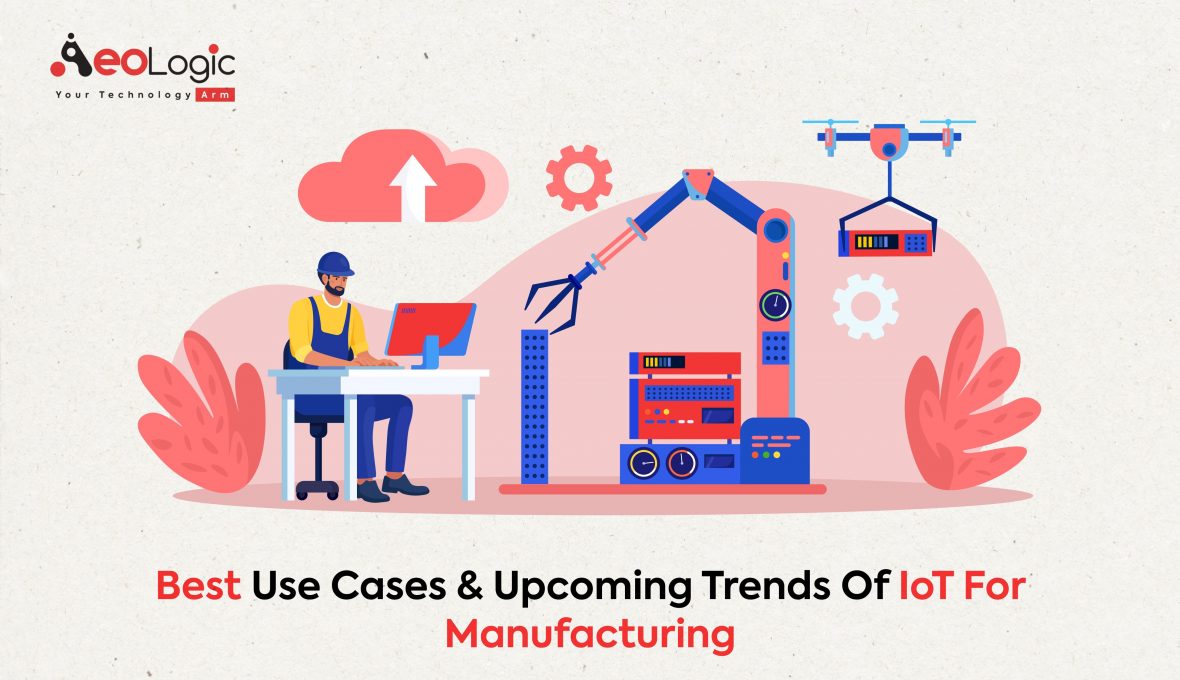The manufacturing world is evolving at breakneck speed. As this evolution continues, one term you’ve probably heard more and more frequently is “Internet of Things” or IoT. This isn’t just a buzzword; it’s the future. Especially when we talk about the “Trends of IoT for Manufacturing.” But what are these trends, and why should the manufacturing industry care? Let’s dive in!
What Is IoT, and Why Does It Matter?
Simply put, IoT involves connecting devices to the internet or to each other. In manufacturing, this means machines, products, and systems sharing data in real time. The insights gathered from this data can lead to increased efficiency, better product quality, and reduced costs.
A statistic from McKinsey Global Institute states that by 2025, the economic impact of IoT in factories could reach up to $3.7 trillion. Why? Because the potential benefits in operational efficiency, product customization, and supply chain management are enormous.
10 Upcoming Trends with Use Cases of IoT for Manufacturing
Trend 1. Predictive Maintenance
Predictive maintenance, powered by IoT, is a game-changer for manufacturers. Instead of routine checks, sensors placed on machines can continuously gather data on performance metrics like temperature, vibration, and wear. By using machine learning algorithms, anomalies are detected early on, allowing timely intervention. This method isn’t just efficient it’s cost-saving. Sumatosoft’s findings suggest that predictive maintenance can decrease maintenance costs by 12%, curtail unplanned outages by 9%, and elongate machine lifespan by 20%.
Use Case: A large dairy factory integrates IoT sensors to monitor the cooling systems’ health, ensuring milk and dairy products are stored at optimal temperatures. Over time, the system recognizes potential HVAC failures, alerting technicians.
Why it matters: Beyond preventing unplanned downtime, predictive maintenance ensures that perishable goods aren’t compromised. It also offers substantial savings in potential wastage.
Further Insight: By acting on the early warnings, businesses can also extend the life cycle of their equipment, ensuring that capital investments last longer and offer better returns on investment.
Also Read: The Importance of Information Technology in Healthcare
Trend 2. Quality Control & Assurance
The integrity of a product defines a brand. With IoT, manufacturers can boost this integrity. Sensors can continually scan products on the production line, measuring attributes such as size, weight, and even chemical composition. These real-time insights mean that faulty products can be immediately rectified or removed, leading to a considerable reduction in defects and recalls.
Use Case: A smartphone manufacturing plant uses IoT sensors to test touch sensitivity, battery efficiency, and software performance for every device.
Why it matters: Ensuring each smartphone meets the company’s standards enhances brand reliability. Consumers trust in a product’s consistency and quality.
Further Insight: Quality assurance via IoT can also streamline the return and repair process, potentially saving manufacturers millions in associated costs.
Get in touch with us to know more about IoT Solutions!
Trend 3. Smart Inventory Management
Gone are the days of tedious inventory checks. With IoT-powered RFID tags and sensors, real-time data about stock levels is always at hand. This not only facilitates automated restocking but also reduces storage costs. An optimized inventory system ensures that resources are utilized efficiently, reducing wastage and increasing profit margins.
Use Case: In a large warehouse for e-commerce goods, RFID tags monitor the stock of popular items, triggering an automated restock order when quantities run low.
Why it matters: Accurate inventory data prevents overselling products, which can negatively impact customer satisfaction and brand reputation.
Further Insight: Such an automated system can also give insights into sales trends, helping in demand forecasting and inventory optimization.
Also Read: IoT Integration in Smart Cities for a Sustainable Future
Trend 4. Enhanced Worker Safety
Factories can be hazardous environments. With wearable IoT devices like safety vests or helmets, the health and safety of workers can be continually monitored. These wearables can track metrics like heart rate, body temperature, and even detect exposure to harmful gases. If a worker’s vitals cross a certain threshold or they enter a dangerous zone, instant alerts ensure rapid response, potentially saving lives.
Use Case: In a mining operation, workers are equipped with IoT wearables that measure oxygen levels and monitor possible cave-in vibrations.
Why it matters: In high-risk industries, worker safety is paramount. These devices can potentially save lives by giving early warnings.
Further Insight: Enhanced safety measures can also lead to lower insurance premiums and better compliance with industry regulations.
Also Read: How Can IoT Ensure Sustainable Development & Energy Efficiency in Hotels?
Trend 5. Energy Efficiency & Sustainability
As industries worldwide strive for greener operations, IoT offers a solution. By integrating sensors into machinery and lighting systems, energy consumption is constantly monitored. During off-peak hours or low activity phases, systems can automatically power down or switch to energy-saving modes. This not only reduces costs but also contributes significantly to environmental conservation.
Use Case: A paper mill uses sensors to monitor water usage in real-time, recycling and purifying water wherever possible, thereby reducing waste.
Why it matters: In an era of climate consciousness, sustainable operations can boost a company’s image while also leading to considerable savings.
Further Insight: With many countries offering tax incentives for green operations, energy efficiency can also result in significant financial benefits.
Trend 6. Real-time Monitoring & Analytics
Real-time data is the heart of modern decision-making. IoT systems can provide managers and supervisors with up-to-the-minute stats on every aspect of the manufacturing process, from machine performance to worker productivity. Such immediate insights enable swift decisions, optimizing operations on-the-fly.
Use Case: A beverage company has integrated IoT to monitor the sugar content in every drink, ensuring consistency and health standards.
Why it matters: With consumers becoming more health-conscious, ensuring product consistency protects brands from potential health-related lawsuits.
Further Insight: Real-time analytics can also offer insights into production bottlenecks, paving the way for further process optimization.
Also Read: Role of 5g Technology in the Digital Economy
Trend 7. Remote Operations
The future is remote. With IoT, machinery and systems can be monitored and controlled from anywhere in the world. This minimizes the need for constant on-site supervision and allows experts from around the globe to intervene without ever setting foot on the factory floor.
Use Case: A global chocolate manufacturer monitors the roasting of cocoa beans in factories worldwide from a central hub, ensuring consistency in flavor profiles.
Why it matters: Centralized control ensures that products maintain a consistent quality regardless of where they are produced.
Further Insight: Remote monitoring can significantly reduce travel and training costs, allowing for centralized expertise to oversee global operations.
Also Read: Why the Internet of Things Needs 5G Connectivity
Trend 8. Customization & Personalization
The modern consumer seeks personalization. IoT systems can tap into this demand. By integrating feedback systems into e-commerce platforms, factories can receive immediate data on individual consumer preferences. This allows them to tailor-make products, ensuring that what hits the market is precisely what the consumer desires.
Use Case: An online eyewear retailer uses IoT to get real-time feedback from users about frame comfort, adjusting designs accordingly in subsequent manufacturing.
Why it matters: Meeting specific consumer needs can create a loyal customer base and allow businesses to stand out in a crowded market.
Further Insight: Gathering data on customization can also reveal broader market trends, guiding future product development.
Trend 9. Integrated Supply Chain
Integration is key to efficiency. The entire supply chain—from raw material suppliers to retailers—can be interconnected through IoT. This ensures real-time updates on stock levels, demand predictions, and transport logistics. An integrated supply chain means reduced lead times, increased responsiveness, and enhanced customer satisfaction.
Use Case: An automobile manufacturer integrates IoT across suppliers, ensuring timely delivery of parts, streamlining assembly, and reducing wait times for end consumers.
Why it matters: An efficient supply chain can drastically reduce production times, leading to quicker deliveries and enhanced customer satisfaction.
Further Insight: Integrated supply chains are more resilient to disruptions, ensuring continuity even in unforeseen circumstances.
Trend 10. Robotics & Automation
Machines are taking center stage, and when infused with IoT, they’re smarter than ever. IoT-enabled robots can communicate with other systems, adjust operations based on real-time data, and even make independent decisions based on preset algorithms. This automation is poised to drastically reduce human error, optimize resources, and skyrocket productivity.
Use Case: A book distributor uses IoT-powered robots that can sort and package books based on genre, size, and destination, adjusting in real-time to order influxes.
Why it matters: Automation allows for rapid scalability, ensuring that businesses can handle peak demands without compromising on speed or quality.
Further Insight: As robots become more sophisticated and integrated with IoT, they can perform increasingly complex tasks, further pushing the boundaries of automation in manufacturing.
Final Words
The Trends of IoT for Manufacturing are not just buzzwords they’re a testament to where the future of manufacturing is headed. From enhancing productivity to ensuring sustainability, IoT promises a revolution on the factory floor. As we’ve explored, these aren’t mere predictions; they’re already being implemented by forward-thinking manufacturers across the globe.
These trends are just the tip of the iceberg. The possibilities with IoT in manufacturing are vast and expansive.
So, are you ready to be a part of this revolution? Connect with Aeologic Technologies to embrace the Trends of IoT for Manufacturing, and ensure that your business is not just a part of the future, but is shaping it.






